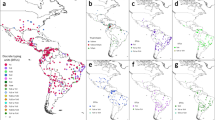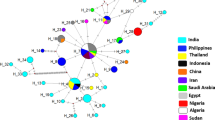Abstract
According to the genetic characterization by the analysis of the miniexon gene, strains of Trypanosoma cruzi can be classified into six discrete typing units (DTUs), and the DTU 1 into four distinct genotypes associated with different life cycles. While Chagas disease is endemic in Costa Rica, T. cruzi isolates from this region have never been genetically characterized. An analysis of 16 isolates from Costa Rica, based on miniexon gene analysis, showed the existence of two different haplotypes in the country, closely related to the Colombian haplotype group TcIa and to sequences from several Mexican isolates, with eight variable positions in the alignment and a variability of 2.6 % between the compared sequences. No relationship between the habitat, vector or host, and the haplotypes was found, suggesting an active flow of T. cruzi in the country. The present study also reports a very high infection rate (47.3 %, 26 out of 55 specimens) in a Costa Rican population of Triatoma dimidiata, the main vector of Chagas disease in this country. The distribution and abundance of the parasite and its main vector suggest a high risk of Chagas disease emergence in Costa Rica.


Similar content being viewed by others

References
Blandón-Naranjo M, Zuriaga MA, Azofeifa G, Zeledón R, Bargues MD (2010) Molecular evidence of intraspecific variability in different habitat-related populations of Triatoma dimidiata (Hemiptera: Reduviidae) from Costa Rica. Parasitol Res 106:895–905
Bosseno MF, Barnabé C, Magallón Gastélum E, Lozano Kasten F, Ramsey J, Espinoza B, Brenière SF (2002) Predominance of Trypanosoma cruzi lineage I in Mexico. J Clin Microbiol 40:627–632
Brito CM, Lima MM, Sarquis O, Pires MQ, Coutinho CF, Duarte R, Pacheco RS (2008) Genetic polymorphism in Trypanosoma cruzi I isolated from Brazilian Northeast triatomines revealed by low-stringency single specific primer-polymerase chain reaction. Parasitol Res 103:1111–1117
Calderón-Arguedas O, Troyo A, Castro A, Guerrero O, Chinchilla M (2002) Infestación por vectores de la enfermedad de Chagas en cuatro zonas endémicas de la meseta central de Costa Rica. Parasitol Latinoam 57:88–95
Camargo EP (1964) Growth and differentiation in Trypanosoma cruzi. I. Origin of metacyclic trypanosomes in liquid media. Rev Inst Med Trop São Paulo 6:93–100
Cura CI, Mejía-Jaramilo AM, Duffy T, Burgos JM, Rodriguero M, Cardinal MV, Kjos S, Gurgel-Gonçalves R, Blanchet D, De Pablos LM, Tomasini N, Da Silva A, Russomando G, Cuba Cuba CA, Aznar C, Abate T, Levin MJ, Osuna A, Gürtler RE, Diosque P, Solari A, Triana-Chávez O, Schijman AG (2010) Trypanosoma cruzi I genotypes in different geographic regions and transmission cycles based on a microsatellite motif of the intergenic spacer of spliced leader genes. Int J Parasitol 40:1599–1607
Falla A, Herrera C, Fajardo A, Montilla M, Vallejo GA, Guhl F (2009) Haplotype identification within Trypanosoma cruzi I in Colombian isolates from several reservoirs, vectors and humans. Acta Trop 110:15–21
Fernandes O, Santos SS, Copulillo E, Mendonca B, Derre R, Junqueira ACV, Santos LC, Sturm NR, Naiff RD, Barret TV, Campbell DA, Coura JR (2001) A mini-exon multiplex polymerase chain reaction to distinguish the major groups of Trypanosoma cruzi and T. rangeli. Trans R Soc Trop Med Hyg 95:97–99
Gómez-Lince LF (1968) El problema de la enfermedad de Chagas en Guayaquil. Rev Ecuat Hig Med Trop 25:3–10
Guhl F, Ramírez JD (2011) Trypanosoma cruzi I diversity: towards the need of genetic subdivision? Acta Trop 119:1–4
Guzmán-Marin E, Barrera-Pérez MA, Rodriguez-Félix ME, Zavala-Velázquez JE (1992) Hábitos biológicos de Triatoma dimidiata en el Estado de Yucatán, México. Rev Biomed 3:125–131
Herrera C, Bargues MD, Fajardo A, Montilla M, Triana O, Vallejo GA, Guhl F (2007) Identifying four Trypanosoma cruzi I isolate haplotypes from different geographic regions in Colombia. Infect Genet Evol 7:535–539
Herrera C, Guhl F, Falla A, Fajardo A, Montilla M, Vallejo GA, Bargues MD (2010) Genetic variability and phylogenetic relationships within Trypanosoma cruzi I isolated in Colombia based on miniexon gene sequences. J Parasitol Res ID 897364
Higo H, Miura S, Agatsuma T, Mimori T, Yanagi T, Iwagami M, de Arias AR, Matta V, Hirayama K, Takeuchi T, Tada I, Himeno K (2007) Identification of Trypanosoma cruzi sublineages by the simple method of single-stranded conformation DNA polymorphism (SSCP). Parasitol Res 100:1023–1031
Luna-Marín KP, Jaramillo-Londoño CL, Hernández-Torres J, Gutiérrez-Marín R, Vallejo GA, Angulo-Silva VM (2009) ITS-RFLP- and RAPD-based genetic variability of Trypanosoma cruzi I, human and vector strains in Santander, Colombia. Parasitol Res 105:519–528
Mejía-Jaramillo AM, Arboleda-Sánchez S, Rodríguez IB, Cura C, Salazar A, Del Mazo J, Triana-Chávez O, Schijman AG (2009) Geographical clustering of Trypanosoma cruzi I groups from Colombia revealed by low-stringency single specific primer-PCR of the intergenic regions of spliced-leader genes. Parasitol Res 104:399–410
Monroy MC, Bustamante DM, Rodas AG, Enriquez ME, Rosales RG (2003a) Habitats, dispersion and invasion of sylvatic Triatoma dimidiata (Hemiptera: Reduviidae: Triatominae) in Peten, Guatemala. J Med Entomol 40:800–806
Monroy C, Rodas A, Meja M, Rosales R, Tabaru Y (2003b) Epidemiology of Chagas disease in Guatemala: infection rate of Triatoma dimidiata, Triatoma nitida and Rhodnius prolixus (Hemiptera, Reduviidae) with Trypanosoma cruzi and Trypanosoma rangeli (Kinetoplastida, Trypanosomatidae). Mem Inst Oswaldo Cruz 98:305–310
O’Connor O, Bosseno MF, Barnabé C, Douzery EJP, Brenière SF (2007) Genetic clustering of Trypanosoma cruzi I lineage evidenced by intergenic miniexon gene sequencing. Infect Genet Evol 7:587–593
Pennington PM, Paiz C, Grajeda LM, Cordón-Rosales C (2009) Concurrent detection of Trypanosoma cruzi lineages I and II in domestic Triatoma dimidiata from Guatemala. Am J Trop Med Hyg 80:239–241
Roellig DM, Brown EL, Barnabé C, Tibayrenc M, Steurer FJ, Yabsley MJ (2008) Molecular typing of Trypanosoma cruzi I isolates, United States. Emerg Inf Dis 14:1123–1125
Rugai E (1941) Cultura das leishmanias. Rev Inst Adolfo Lutz 1:153–159
Ruíz-Sánchez R, De León MP, Matta V, Reyes PA, López R, Jay D, Monteón VM (2005) Trypanosoma cruzi isolates from Mexican and Guatemalan acute and chronic chagasic cardiopathy patients belong to Trypanosoma cruzi I. Mem Inst Oswaldo Cruz 100:281–283
Santos-Mallet JR, Silva CS, Gomes SA, Oliveira DL, Santos CL, Sousa DM, Pinheiro NL, Junqueira AC, Gonçalves TC (2008) Molecular characterization of Trypanosoma cruzi sylvatic isolates from Rio de Janeiro, Brazil. Parasitol Res 103:1041–1045
Sousa OE, Wolda H, Batista F (1983) Triatominos encontrados en el ambiente silvestre de la Isla Barro Colorado. Rev Med Pan 8:50–55
Souto RP, Fernandes O, Macedo AM, Campbell DA, Zingales B (1996) DNA markers define two major phylogenetic lineages of Trypanosoma cruzi. Mol Biochem Parasitol 83:141–152
Tamura K, Peterson D, Peterson N, Stecher G, Nei M, Kumar S (2011) MEGA5: molecular evolutionary genetics analysis using maximum likelihood, evolutionary distance, and maximum parsimony methods. Mol Biol Evol 28:2731–2739
Thomas S, Westenberger SJ, Campbell DA, Sturm NR (2005) Intragenomic spliced leader RNA array analysis of kinetoplastids reveals unexpected transcribed region diversity in Trypanosoma cruzi. Gene 352:100–108
Venegas J, Miranda S, Coñoepan W, Pîchuantes S, Jercic MI, González C, Gajardo M, Apt W, Arribada A, Sánchez G (2010) Microsatellite marker analysis shows differentiation among Trypanosoma cruzi populations of peripheral blood and dejections of Triatoma infestans fed on the same chronic chagasic patients: microsatellite marker analysis and T. cruzi. Parasitol Res 107:855–863
Yeo M, Acosta N, Llewellyn M, Sánchez H, Adamson S, Miles GAJ, López E, González N, Patterson JS, Gaunt MW, Rojas de Arias A, Miles MA (2005) Origins of Chagas disease: Didelphis species are natural hosts of Trypanosoma cruzi I and armadillos hosts of Trypanosoma cruzi II, including hybrids. Int J Parasitol 35:225–233
Zeledón R, Rojas J (2006) Environmental management for the control of Triatoma dimidiata (Latreille, 1811), (Hemiptera: Reduviidae) in Costa Rica: a pilot project. Mem Inst Oswaldo Cruz 101:379–386
Zeledón R, Solano G, Burstin L, Swartzwelder JC (1975) Epidemiological pattern of Chagas disease in an endemic area of Costa Rica. Am J Trop Med Hyg 24:214–225
Zeledón R, Montenegro VM, Zeledón O (2001) Evidence of colonization of man-made ecotopes by Triatoma dimidiata (Latreille, 1811) in Costa Rica. Mem Inst Oswaldo Cruz 96:659–660
Zeledón R, Calvo N, Montenegro VM, Lorosa ES, Arévalo C (2005) A survey on Triatoma dimidiata in an urban area of the province of Heredia, Costa Rica. Mem Inst Oswaldo Cruz 100:607–612
Zingales B, Andrade SG, Briones MRS, Campbell DA, Chiari E, Fernandes O, Guhl F, Lages-Silva E, Macedo AM, Machado CR, Miles MA, Romanha AJ, Sturm NR, Tibayrenc M, Schijman AG (2009) A new consensus for Trypanosoma cruzi intraspecific nomenclature: second revision meeting recommends TcI to TcVI. Mem Inst Oswaldo Cruz 104:1051–1054
Acknowledgments
This study was funded by the Red de Investigación de Centros de Enfermedades Tropicales (RICET) (projects numbers C03/04, ISCIII2005-PI050574, and ISCIII-RETIC RD06/0021/0017 of the Programa de Redes Temáticas de Investigación Cooperativa RETICS/FEDER), FIS, Ministry of Health, Madrid, Spain; MICIT (Science and Technology Ministry, Costa Rica) and CONICIT (Science and Technology Research Council, Costa Rica). Technical support was provided by the Servicio Central de Secuenciación para la Investigación Experimental (SCSIE) of the University of Valencia, Spain.
Author information
Authors and Affiliations
Corresponding author
Rights and permissions
About this article
Cite this article
Zuriaga, M.Á., Blandón-Naranjo, M., Valerio-Campos, I. et al. Molecular characterization of Trypanosoma cruzi and infection rate of the vector Triatoma dimidiata in Costa Rica. Parasitol Res 111, 1615–1620 (2012). https://doi.org/10.1007/s00436-012-3000-0
Received:
Accepted:
Published:
Issue Date:
DOI: https://doi.org/10.1007/s00436-012-3000-0



